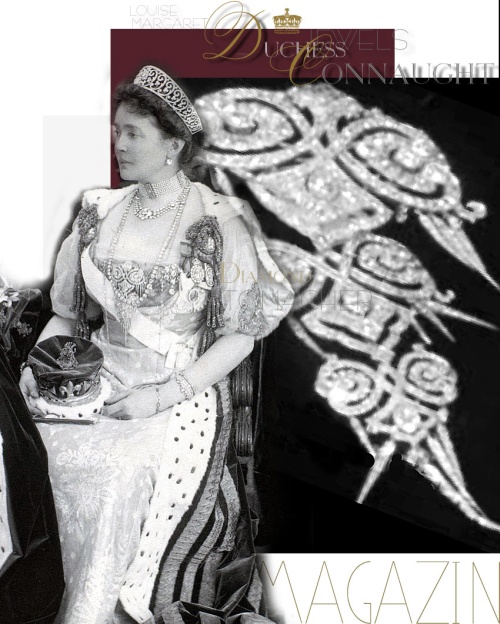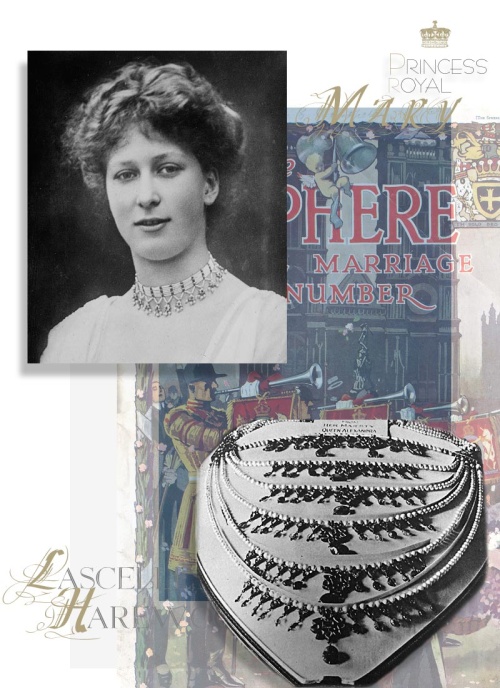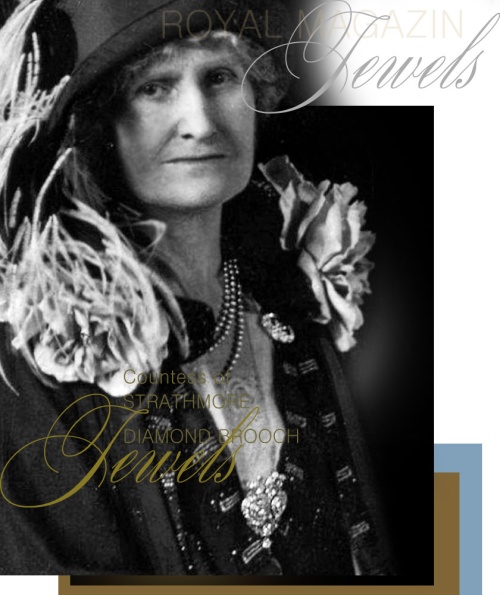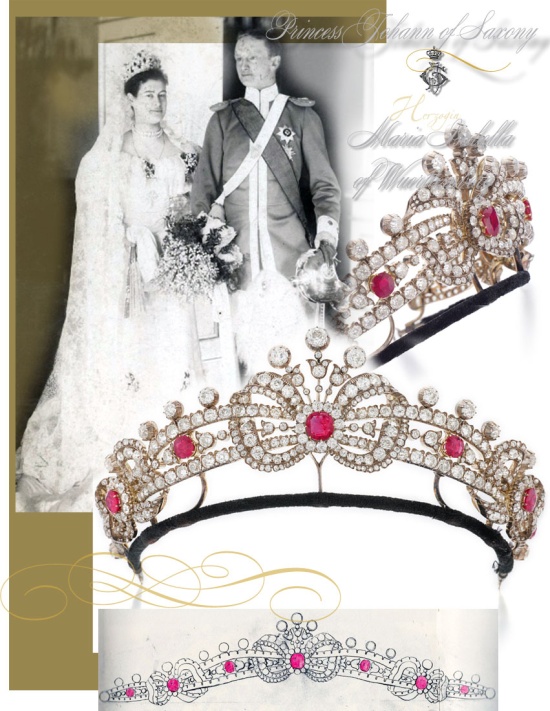
…..long emerald „pendentifs“ hanging on both sides of her face. Some superb emeralds and diamonds completed her attire…..the round emeralds were from the collection of his mother-in-law Infanta Eulalia of Spain.
Royal Jewels, royal jewel, royals, royalty
Magnificent Jewels of Queen Victoria Eugenie of Spain

It is an important brooch in the Art Deco style, consisting of two emeralds in sugarcoat – one oval size and one cushion size. It is very likely that they were two separate brooches that queen Victoria Eugenie decided to wear it in the fashion of the 20s has to be put together in one piece as there is in the picture in which we can see her wearing as pendant
EARLY 20TH CENTURY EMERALD AND DIAMOND PENDENT BROOCH
Sugarloaf and oval-shaped cabochon emeralds, old, rose, and calibré-cut diamonds, platinum, single pin detachable of later addition, circa 1915
8.5 x 4.1 cm weight: 37.3 grams Christie’s Geneva
Princess Elisabeth of Hesse and by Rhine daughter of Ernst-Ludwig, last Grand Duke of Hesse and by Rhine, and Princess Victoria Melita of Saxe-Coburg-Gotha


What’s happened about this treasure…..
The 32 Faberge Easter Eggs in Detail from the Collection of Princess Elisabeth of Hesse

The Duchess of Connaught, the photograph was taken at the Coronation of King George V 1911, 1865-1936.



Wedding diamonds from Count Glamis, later Count of Strathmore and Kinghorne, to Cecilia Cavendish-Bentinck- two inwinded hearts in diamonds with a crown as pendant, large brooch, worn on the wedding of the Duke and Duchess of York in 1923 Countess Strathmore Diamond Jewels Marriage Bridal Jewels Wedding Gift in 1881 |
A mystery is solved about a part of the Romanov Crown Jewels:
More about the history of an extraordinary necklace, from the Russian Empresses to the heiress and ambassadress Mrs Thompson-Biddle in Paris.


Mrs Margaret Thompson Biddle, an american heiress and wife of the Ambassador Anthony Drexel Biddle Jr.
Mrs. BIDDLE Paris 1948 Opera l’O.N.U le president de la Republique, des ministres, des ambassadeurs— the press noted:
La plus belle rivière de diamants de l assemblée. Fourreau de velours noir brodé de strass de Balenciaga.
«Leurs» robes et «leurs» bijoux
LA BARONNE SELLIERE. — Brocart bleu et blanc, rivière et bracelets de diamants.
LA PRINCESSE DE FAUCIGNY-LUCINGE. — Tout en noir ; n’a pas quitté son chapeau (tyrolien à plumes) ni sa cape de zibeline. Pas de bijoux.
Mrs. BIDDLE. — La plus belle rivière de diamants de 1 assemblée. Fourreau de velours noir brodé de strass de Balenciaga.
LA DUCHESSE DE MAILLE. — Jupe de tulle et corselet bleu saphir sans épaulettes. Triple collier d’émeraudes et diamants
LA COMTESSE DE CASTELLANE. — Satin noir à épaulettes, triplé rang de perles.
Mme VOLTERRA. — Satin noir broché or, pendante et bracelets de diamants. Cheveux « hermine rosée ».
LA PRINCESSE GALITZINE. — Velours noir, cheveux argentés, toutes les bagues au même doigt.
LA COMTESSE DE POLIGNAC (Jeanne Lan vin Junior). — Cheveux cendrés, fourreau velours noir et satin vert ; pas de bijoux.
ANNABELLA. — Long fourreau blanc à « cornichons » d’or ; bracelets de diamants.
PRALINE (Miss Cinémonde). — Fourreau de satin gris acier brodé par Balmaln, longue cape de renard blanc.
Patricia ROC. — Justaucorns de tulle nègre et jupe de tulle blanc, pas de bijoux, cheveux argent.
Espanita CORTEZ. — Mantille de dentelle noire (naturellement), cape de renard platine et fourreau de satin noir.
IA DUCHESSE DE PREMIO REAL. — Tulle blanc et dentelle noire, pendentif et collier de diamants.
Mme CONSTANTIN ESCO. — Moire périnée de mauve et blanc (de Jacques Fath), avec une lourde parure de rubis et diamants.
Josette DAYDE. — Gorgerette et fourreau de satin gris.
Renée SAINT-CYR. — Cheveux flous sur les épaules, cape de renard platine.
Maria MONTEZ. — Robe de mousseline bayadère bleu et blanc, cheveux coupés court* sur les oreilles, pas de bijoux.
Mme FRANCHOT TONE. — Fourreau noir à revers de satin rose au corsage sans épaulettes, étole de satin rose et coiffure très américaine avec frange du plus franc blond platine.
Maureen O’HARA. — Robe de style en dentelle vert émeraude, cheveux rouge sang, maquillage pâle, pa* de bijoux.
Germaine ROGER. — Robe de satin framboise et boléro de renard bleu.


Duchess of Albany Wedding | Heirloom Jewels Fürstin Helene zu Waldeck-Pyrmont, Princess of Nassau
Wedding Jewels | Princess Helen of Waldeck -Pyrmont Duchess of Albany | Hochzeits-Schmuck
Princess Helen’s Snake Bracelet | Prinzessin Helene’s Schlangenarmband aus Brillanten
The Wedding gifts of Duchess Helen | Die Hochzeitsgeschenke der Herzogin Helen Albany in engl.
Princess Waldeck -Pyrmonts Portrait a gift of the Queen | Geschenkeliste zur Vermählung in Deutsch
Wedding presents, Bracelets for Helen Princess of Waldeck-Pyrmont | Schmuck -Armbänder zur Hochzeit

The first wife of Prinz Johann Georg von Sachsen – Herzogin Maria Isabella von Württemberg on her wedding day.

This magnificent piece was subsequently passed down to her nephew, Albrecht Eugen, Duke of Württemberg (1895-1954).
Above we see his daughter, Duchess Sophie of Württemberg wearing the tiara in the 1960s and she wore it again in the 1990s.
It will be offered from Sotheby’s, at auction in the year 2023 „Vienna 1900 An Imperial and Royal Collection“ at Geneve.
It was sold for 762,000 CHF